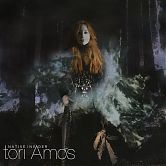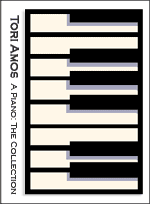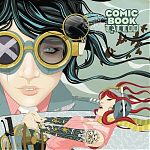- Articles
- Cherries
- Minutiae
- Q&A
- RAINN
- Releases
- Reviews
- Site News
- Them
- Toriphiles
- Touring
- TV/Radio/Web
- Video
News Archives
Keep an eye on our Twitter and Facebook pages since we often post quickie updates there when we're on-the-go.
During tours, we do our best to cover setlists in real-time on Twitter. If you want to tweet a show in, just DM or @ us on the day and tell us to watch your stream that night.
Tori is touring in 2017 to support the release of Native Invader. The European legs runs from early September through early October and the North American leg runs from late October to early December. We do not know if additional dates elsewhere will be added.

Native Invader (album, 2017)

Unrepentant Geraldines (album, 2014)

Gold Dust (album, 2012)

Night of Hunters (album, 2011)

Midwinter Graces (album, 2009)
 Abnormally Attracted To Sin (album, 2009)
Abnormally Attracted To Sin (album, 2009)
Live at Montreux 1991/1992 (DVD, 2008)

American Doll Posse (album, 2007)

A Piano (boxed set, 2006)

Pretty Good Years
(bio, 2006)

Fade To Red
(DVD, 2006)
 Comic Book Tattoo (book, 2008)
Comic Book Tattoo (book, 2008)News: Record Collector Article (November, 2006)
Tales of the Bee Mistress
Tori Amos has ‘restored’ her back catalogue for a new box set. James R Blandford talked to her about the project and discovered that you can’t make A Piano without a few bees.
The box set is a mixed blessing for a contemporary artist – an honour more often bestowed on the grave-bound or terminally retired. As Tori Amos is neither of these, the release of a 5-CD retrospective from Rhino is a surprisingly welcome windfall for fans of the compellingly eclectic musician whose intimate rapport with her muse has produced nine studio albums in 16 years. This musical legacy has already proven ripe for the picking, though her career shows no signs of slackening. A new studio album album is all but completed and due for release in spring 2007.
The 86 tracks on A Piano gather remastered classics, B-sides, alternative mixes, and seven previously unreleased tracks. The quality of the remasters is superb, but collectors will be most excited by the unreleased cuts and demos. Of these, “Take Me With You” is the stand-out – a unique melding of an undeveloped Little Earthquakes left-over brought up to date with a 2006 lyric and vocal. “Dolphin Song,” inexplicably discarded from 1998’s From the Choirgirl Hotel, is equally enchanting. Later outtakes such as “Not David Bowie,” “Zero Point,” and “Peeping Tommi” impress with their breadth of sheer experimentalism.
It’s a stiflingly hot day when Record Collector meets Amos, ensconced in her piano room at the recently completed Martian Studios. The recording complex adjoins her 300-year-old farmhouse in Cornwall, the splendidly modern interior of which is in stark contrast to the Old World charm of its isolated locale. The room is lined with bookshelves stuffed with titles encompassing everything from Jungian theory to neo-paganism. On top of the Bosendorfer piano that dominates the room lie a huge art book covered with neatly transcribed lyrics, a pack of Mother Earth Tarot cards, and an old paperback edition of Dion Fortune’s The Sea Priestess. A brief discussion of books leads on to the new box set, the opening disc of which comprises an expanded edition of Amos’ seminal 1991 debut, Little Earthquakes.
Did you have any trepidation about restructuring Little Earthquakes? Many fans would argue it needed no re-touching at all.
I look at things conceptually. I have friends who are stonemasons, and they have worked on old monasteries in Tuscany. They try to retain parts of it, yet it’s crumbling. They have to bring it into the modern age so that it will survive another couple of hundred years. So when you take on a project like this, the whole philosophy was that, for the early material, we needed to find and chronicle that time.
We realised, even before we listened, that some of the original masters had been badly damaged. So then we had to take on board the idea that if you’re going to demand that it has to be that mix that happened in 1991 then we’ll have to take it off the CD. So I said, no. Go back and get what you can glean from any other storage places. Bring it all back and then let’s see what we have.
So Mark [Hawley, Amos’ husband and sound engineer] went to LA, worked at Capitol for a couple of weeks, and told me that he had discovered some alternate mixes that might have been done within hours. And what people who don’t make records might not understand is that, when you’re mixing back-to-back like that, it’s not about one mix. You’re doing variations on a theme. We’ll do the vocal up a little here in the bridge, or maybe we have the intro up with the piano and pull it back, so they’re small changes. Then we’ll always have mixes that are a different read, too. Which meant that, in the store-house, we had alternate mixes that went back to 1990. That rescued us from this plight that some of the masters are gone.
Others aren’t gone, but they’re not holding up. They’ve gone back and forth between England and the States and, however they were shipped or whatever happened to them, they’re dull. Because of this I chose to do Under the Pink first. I did Disc B and Disc C and then I went to Disc A. We got our sea legs with Pink and Pele. Mark and Marcel (van Limbeek) were the engineers on those, so we had a real reference point.
So the later masters were in better shape?
Pink was pretty much intact. We did use some alternate mixes, but that’s just because we had a few. But it’s really important that these were not songs that were remixed in 2006. These were alternate mixes that happened within that time frame. It might have been that we had two mixers on Under the Pink, so they both had a crack at everything and we used one of the other’s takes. What’s important is that, with the early records, I’ve tried to chronicle time. Tales of a Librarian was more of a remixing and a reinterpretation to get the best audio we could now. The box is trying to give you the best of what we have from 1990 that retains the character but is the best that exists at this time. Sometimes it’s better.
Don’t take this wrong, but you can’t sit and listen to this on shitty speakers and tell me that you like a mix better. You have to sit in front of PMCs and talk to me like an audiophile and I’ll consider what you have to say. Because if you’re sitting in your Saab, like I have, it’s a cute colour but it’s a piece-of-shit stereo. Anything that we have done has just been bastardised by the fucking Saab.
I don’t mean to be long-winded, but it was sacrosanct for me to try and bring to you the truth of that time in the best way possible.
One of the previously unreleased cuts, “Take Me With You,” was originally an instrumental from the Little Earthquakes sessions. Now you’ve recorded a vocal. Why was the track abandoned?
The truth is, there was a vocal on the 1990 take, and the lyrics to the chorus are the same. I’ve retained the chorus and parts of the bridge and used it as a skeleton. Then I worked around what was just humming in the verses. But the bridge was close to being there and the choruses were intact, so I haven’t changed a word. It made an impact, but you can’t put an unfinished work like that out. The way I was singing it, it was only a completed bottom chorus, so it wasn’t a finished idea. Maybe at the time I wasn’t able to really write what she wanted to be. I think that the journey that this song creature has made is really a story in itself. Sometimes I think about old visual artists and how it might take them years to finish a piece and how they’ve had to travel the world in order to finish their vision.
So, where did the words come from?
Viktor and Rolf, the designers from Holland, called and asked me to do a piece for them (in 2005). They’re quite subversive in their way and, being Dutch, they’re very liberal and their viewpoint comes from a place I think of as closer to where I am. They had just made this perfume called Flowerbomb, so when they asked me to do it, the first thing I thought of was the war in the Middle East and There Is A Bomb In Gilead (sic). So I thought, let’s go back to the Old Testament.
I’d been immersed in the bee culture, of the Bee Masters and the Bee Mistresses when I was making The Beekeeper. Some of them had shown up at my door before anyone knew about the album. I met this one Bee Master and he talked to me about the Song Of Solomon and how important that was for the feminine side, and how Christianity and Judaism and Islam were trying to kill the Goddess archetype.
It’s a sacred verse to the Bee Mistress and the Bee Masters in their ceremonies, where women marry their sexuality and their sacredness. So I thought I’m going to take some of the words of the Song Of Solomon and this song just came. And it was “Take Me With You.”
I retained the chorus I had written in 1990, then I wrote many verses that talked about now. It was an improv piece. I’ve done it once in my life. I went into a trance, I studied the verse and I had the melody. I had to trust that it would be a one-off piece for Viktor and Rolf.
So what happened to change that?
Well, then Mark called me from Capitol Studios and said, ‘We found a previously unreleased track from Little Earthquakes called “Take Me With You.” Why don’t you use it?’ And I said, ‘Well it’s not finished.’
So he brought it back and I tried to re-track it for Under the Pink. But I couldn’t. It didn’t work. The magic had gone and I couldn’t finish the thought, I didn’t know where it would be. So I put it away.
I tried to track it the first time that I met Matt Chamberlain, but again I didn’t have a verse. It was just a chorus. He said to me, ‘Tori you’ve gotta finish this, then we should develop it.’ So for five days they just put a mic up in room and I did it. But if I hadn’t done the song with Viktor and Rolf, I don’t think that I would have been able to approach it again. I needed to take it into another form and then come back to it. I had to explore the Song Of Solomon to see what a romance can be in the midst of all that’s happening in the story. I had to experience it.
It talks about a father, but she’s agonising about her father’s torment. ‘My cape was never worn/My father’s robe is torn/Between the cross and the mother.’ There are accusations in there. There is questioning. It does take you back to the witch trials and it does take you back to my father.
In what way does it relate to your father?
My dilemma with my father has always been he’s not the dark face of the patriarchy – he’s not a George Bush clone. However, I think that he would stand on the side of the patriarchy, because he would choose to believe that Benjamin Franklin, Thomas Jefferson, and Abraham Lincoln are patriarchal, and maybe more liberal. But there’s something worthy about it. He would believe that women should be equal in the church but he would not agree, I don’t think, that you could have a woman Pope. Even though my dad is much more liberal than a lot of them he’s not a liberal. So my war with that way of thinking, as a minister’s daughter, came out in “Take Me With You.” Though there’s love there, we’re very torn, because we do stand on the same side with some issues, but with others we just can’t. People have to pick sides. You have to decide where you stand. So that’s “Take Me With You” – its final point of gestation.
After such a long gestation was the actual birth an easy process, or did you need painkillers?
Well Mark and Marcel said, ‘You’ve got to do this now or it’s gone forever. You can’t use it for the next record because it’s very 1990 and this is perfect. This is what it is.’ It’s a radical move to work off a sacrosanct tape from 1990. First of all you have to be able to think that you can almost channel yourself as you were then, and yet still be you now. A lot of people’s chords are destroyed 16 years later. They’ve smoked too much and coked too much, and so their voice has changed. Maybe they’ve lost five notes of their range. And I’m not saying I haven’t changed – I’ve changed a lot. But you can’t just think that you can walk into an old master and it’s all gonna work. It’s a very dangerous thing. You can hurt yourself.
Some of my contemporaries have changed so much in 16 years that you couldn’t even contemplate doing that. Sometimes changes are for the good, meaning that I think some of my contemporaries sound like women now, instead of young girls. But that’s not the point. The point is, if you’re going to work with something that’s that old, can you and your style and your vocal instrument make sense? I usually don’t get very spooked about challenge, I don’t have a hubris. I know how wrong you can go. You can get things so wrong recording. You really can miss it.
Live is different, because people are there with you. You’re all making love together in a room. What works coming off a disc is a different set of rules. So out of everything in the whole project, that was the one minute I sat there weighing up the options. And I looked at them and I said, ‘Play it again.’ The track seduced me. She just seduced me and I knew that it was her time.
You often refer to your songs as your daughters, and now, of course, you have a flesh-and-blood daughter, too. Is there any sibling rivalry?
Yes, I think there is. I think they get fed up from time to time. Not all of them, but there’s only so much time in the day and I was always a musician first and then a woman second. So, when the mother gets put first over the musician, or the musician gets put over the mother, both factions have problems. It takes a lot of time and effort pulling a project like this together. Everything was remastered, everything was listened to, everything was done by hand. So there were many days when Tash had to forgo her story time, and usually I don’t compromise on that.
How did you decide which other unreleased cuts would make the box set?
Mark started discovering things. Because of the war that I had with Atlantic in 1997, and I guess from Pele, we’ve been storing tapes ourselves that never get to the record company. They get the record and that’s all they get. They don’t get any outtakes anymore, they don’t get anything else.
The way I see it, everybody I deal with who tries to tell me what to do gets fired. So if someone’s trying to tell me what to do, I say, ‘Well you’re gonna be gone soon anyway.’ And I start whistling “Dixie.”
I don’t mean to be so rude. If they have a good comment to make, I don’t care if it comes from the teaboy or from Donnie Einer, who used to be president of Sony. If it’s a good idea, then I’m all there. However, what I began to realise is that I have to make decisions. I have to protect the songs because that’s not anybody’s job but mine.
So it sort of became my covert operation, my Sidney Bristow (from the TV show Alias) moment, where we have been filing and the record company only get what they should get. They always get more than I’m supposed to give them anyway, because, as you know, records aren’t only about what you get paid for. I always give a lot more.
So we put things on that hadn’t been turned in. Songs like “Walk to Dublin,” which is on the Pele disc, “Not David Bowie,” “Dolphin Song,” and the Intro Jam. “Peeping Tommi” was in the store. It wasn’t used but it was on file. So that’s really what you’re getting. And there’s a little demo medley, too.
I was surprised by your inclusion of the demos, as you’ve made it clear that you aren’t fond of work-in-process reaching the public domain. What changed?
I realised that it would be a good thing to offer as a box. But it had to be truthful, it couldn’t be staged. It’s an exposure of an intimate process. I did a demo of “Fairytale,” while we were doing Strange Little Girls, where I just sat down at the piano and sang it on a mic, in between the recording of other people’s songs. We had everything filed there, it had a working title of “Oliver Stone.” When I heard it I knew I could expose that. I won’t show you all five minutes of it, but I’ll show some of it. I show some of “Playboy Mommy,” when it was just getting written, too. I was at the beach house and I had a little set-up and I just pushed record.
Then there was a little bit in front of “Beauty Queen” that didn’t make it into the final cut, “Fire Eater’s Wife,” so that’s there, too. I thought that would be enough for people to get a sense of the writing process. I really did it for the composers out there – people who write and develop and create themselves – so that they could see where these songs had come from, before the final production.
Are you angry that earlier work-in-progress is available on the internet and on factory-pressed bootlegs?
I just don’t react. You can’t. You won’t believe this about me, but I love what computers do. I think it’s essential, especially for going to fight this World War Three that we’re in. It’s not necessarily the war everybody thinks we’re in, but we’re fighting against being controlled as a mass consciousness. And the only way to win is if people can have thoughts uncontrolled by the media, these big newspapers or whatever. So I think it’s important that it exists. And yet, it means that you have to take the good with the bad. You have to realise, if you’re in my position, that things will get out there. And how they get out there? It makes me wonder if there’s a mole at copyright control. But I’d be surprised if there were demos of the last couple of records because I keep it pretty locked up. Are there?
Not that I’m aware of. The demos I’ve heard are all pre-Pele. I’ve heard the alleged Y Kant Tori Read demos, which are quite funny.
Yes! But you know what I think would really be something? The ‘Narada’ Michael Walden stuff I did when I was 18. More recently, I wrote a song called “Skirts on Fire” with – you’ll laugh your ass off – Randy Jackson, the black guy from American Idol. That’s out there and it’s all good fun. I can laugh at that. I can even have a giggle at some of the demos from 15 years ago. But there is a certain point of the creative process, certain choices that are just wrong musically, where you’re fishing.
I give myself permission as a composer to take something somewhere, because I know that I won’t be exposed. If you know that whatever comes out of your mouth is gonna be exposed, then you might not allow yourself to get it so horribly wrong. Sometimes I really push something, and the song is just retching, ‘How can you do that to me? You should be humiliated!’ But I say, ‘How can I make you everything you could be unless I take you down different paths and prove to myself that you don’t wanna go there?’
I refuse to be pigeonholed into one style of music, which I hope the box set shows you over a range of different musical styles and different periods of time. That’s what I really wanted to show.
The album that most challenges preconceptions about you is probably From the Choirgirl Hotel. Did you enjoy revisiting that one? It’s my favourite.
Mine too. When we were listening to Choirgirl, we felt that some songs would really shine like a new penny if we remixed them. So for “Cruel” and “iieee” we used all our experience and technology, as we felt like they could really crank. They were made within the last 10 years, and this was more of an electronic record. Technology has made such progress since then that it’s not really fair to the songs not to use what we know on them. They were designed for technology, and they were all up for it.
We chose not to re-do “Spark,” because we felt that it did what it did and should stay that way. But we used a remix of “Jackie’s Strength” from Tales of a Librarian, for example, because we loved what the strings were doing. They just lit everything so much better than on the original. “Cruel” and “iieee” had so much potential and were two of my favourites on the record. The record company didn’t get them at the time and they probably never would, but I felt that they needed to jump off the speakers.
So why choose to do a box set now? Some people might take it as a statement of retirement, or a chapter being closed.
Well I love the idea that people might think that, and yet I’m one of the younger artists that puts out a box set, so that makes me happy. It’s not that I’m that young, but a lot of people are getting on. They don’t tour every other year, they don’t have a new release coming out. We’ve got a big new release coming out in the spring, and a tour. So knowing that I have that in my back pocket made me think that to be current and creating, alongside putting a retrospective together, is an opportunity that you don’t always have in life. A lot of times you’re a grandmother when you get that opportunity to do the box set – or you’re dead. They came to us and said, ‘You’ve put out a lot of material in a short time.’ And I guess there is. I loved the Zeppelin box set so much, I loved that I could play it and it was holding up next to the sound of other things I was listening to at the time. I think they did a great job on that. So I wanted to give something to people that they could put in their car and they could listen to and, even though some of the material is 16 or 17 years old and you might have that nostalgic feeling, there isn’t anything on it that I feel has suffered from time. Again, it’s refurbishment, so that it will live now, and so that it doesn’t sound so dated sonically.
A Piano is released by Rhino on 28 September.
—-
Top 20 Tori collectables
20. Boys for Pele (East West PROP 100) 1997, UK, promo CD in card sleeve £30
19. Australian Tour Souvenir (East West TA 1) 1992, Australia, four-track promo cassette £30
18. Little Earthquakes (Atlantic 82358-A) 1991, US, promo cassette first issued with unique artwork £30
17. Tea With The Waitress (Atlantic 5498-2) 1994, US, promo interview CD with cues booklet £30
16. Crucify Live EP (East West A 7479 CDX) 1992, UK, CD with four prints £40
15. Holiday Greetings (Atlantic PRCD 6589) 1995, US, promo CD £50
14. Cool On Your Island/Heart Attack at 23 (Atlantic 7-89021) 1988, US, 7” in p/s, credited to Y Kant Tori Read £50
13. Original Bootlegs (Sony 97780) 2005, US, 6-CD box set with hexagonal stickers £50
12. Under the Pink (Atlantic) 1994, Germany, promo CD in square picture folder £50
11. Y Kant Tori Read (Atlantic 81645-1) 1988, USA, LP, credited to Y Kant Tori Read £75
10. Under the Pink & More Pink (Atlantic 7567806072) 1994, Australia/New Zealand, tour edition 2-CD in stickered case £75
9. Silent All These Years (Atlantic WMD 54102) 1992, Japan, 3” CD single £100
8. The Big Picture (Atlantic PR 2298) 1988, USA, promo 12” in p/s, credited to Y Kant Tori Read £100
7. Precious Things (Atlantic PRCD 47422) 1992, USA, promo 5-track CD picture disc £150
6. Y Kant Tori Read (Atlantic 81845-2) 1988, USA, CD in longbox packaging, credited to Y Kant Tori Read, rarer than the promo, as so few copies sold £150
5. Little Earthquakes (Carrere, no cat no) 1992, France, promo CD with picture insert in wooden box with brass plate £150
4. Under the Pink (Carrere, no cat no) 1994, France, promo CD, VHS, and biography in embossed Perspex box £150
3. Under the Pink (Atlantic PRCD 5397-2) 1993, USA, promo CD in withdrawn digipaks with unique artwork £300
2. It’s A Happy Day (private pressing) 1978, USA, one-sided 7”, written by Camilla Wharton £750+
1. Baltimore/Walking With You (MEA MEA 5290) 1980, USA, 7” credited to Ellen Amos £750+
(Transcribed for Undented by menju56.)


